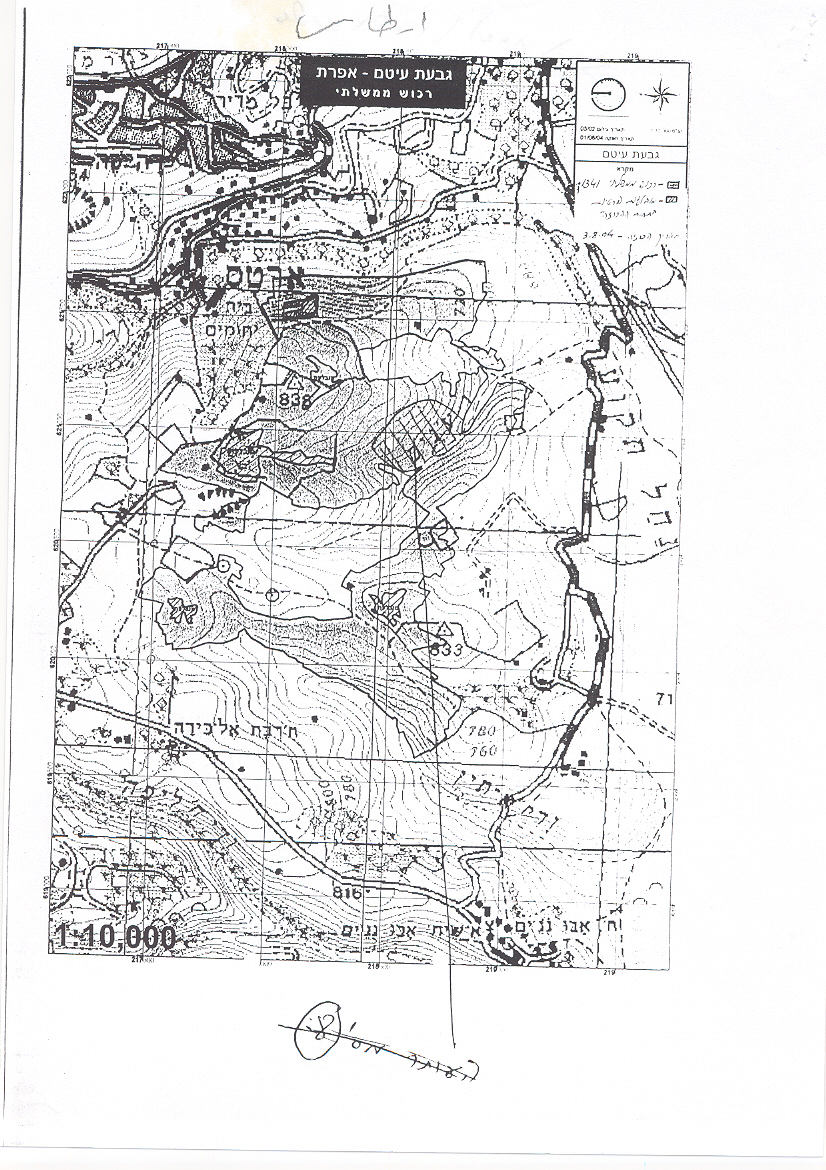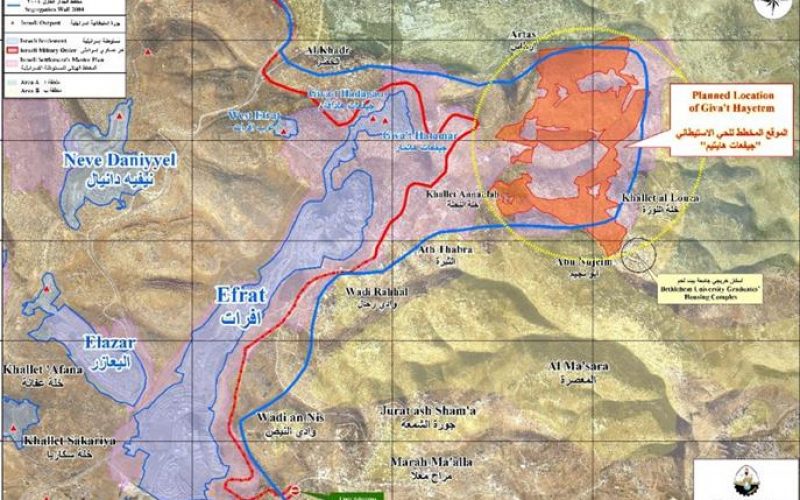The Israeli daily newspaper, Haaretz, reported on the 8th of January 2019 that the Israeli government is allocating nearly 1200 dunams of Palestinian land in Bethlehem Governorate for the establishment of a new settlement neighborhood near the settlement of Efrat, to its east, in an area that has long been a sensitive issue for many reasons. According to the newspaper, the new neighborhood will be a new addition to the list of Israeli settlements in the Israeli so-called Gush Etzion settlement bloc. which is comprised of ten Israeli settlements in the Bethlehem and Hebron Governorates. Haaretz in its report added that the Israeli Civil Administration has allocated the targeted land to the Israeli Housing Ministry in late 2018, a step that would mark the start of the planning phase of the new settlement neighborhood, known as Giv’at Hayetim (Eitam Hill) – the eight hill of Efrat settlement, on the eastern side of the Israeli Segregation Wall.
The story of Giv’at Hayteim settlement neighborhood
In mid-February 2009, the Israeli military court affiliated to the Israeli Civil Administration in Bethlehem Governorate rejected eight of nine petitions filed by Palestinians from Al Khader and Artas villages southwest of Bethlehem city against an Israeli Military Order issued back in 2004, which stated the seizure of 1700 dunums of Palestinian lands in the areas of Khallet An-Nahla and Shu’ab Salman, allegedly for being declared as “State Land”. See Map 1
 Map 1 : The location of the 1700 dunums east of Eftar Settlement
Map 1 : The location of the 1700 dunums east of Eftar Settlement
According to the military order of 2004, the targeted Palestinian lands are located within the master plan of Efrat settlement southwest of Bethlehem city and has been declared by the Israeli Government a “State Land”; however, the lands do not fall within the land area isolated by the Segregation Wall – with regard to the segregation wall map issued by the Israeli Ministry of Defense in 2007. However, and now with the Israeli civil administration allocating the land to the Israeli Ministry Housing, confirming the seizure of the land, things might take a reverse route, meaning that it is likely that the Israeli Government will go back to the planned route for the segregation wall as it was back in 2005; at least with regard to the Etzion settlements’ bloc.
Additionally, the Israeli Government has long been postponing the construction of the wall in that specific area of Bethlehem, stating that a financial issue stands in the way of implementing it; however, facts on the ground reveal the real plan of the Israeli Government, which is to decide on the status of the so called “Giv’at Hayetim Hill” first, and then resolve the dispute over the construction of the Segregation wall in that area so that it includes the new settlement neighborhood within the land area it plans to annex to Israel through the constriction of the wall.
The initial plans for the so-called “Giv’at Hayetim” neighborhood is to construct 2500 housing units.
 |
Photos 1 & 2: The Israeli Military order of 2004 declaring the lands east of Efrat Settlement as “State Land”
Benjamin Netanyahu, the current Israeli prime minister of Israel s well known for his rigged policy toward the peace process with the Palestinians. For him, Jerusalem and the settlements are not on the negotiating table with the Palestinians, and he is only willing to give as little as possible from the occupied territory just enough for the Palestinian to live in, which pretty much where the Palestinian built-up areas stand today. He refuses to debate the settlements issue, as they are illegal, and is unwilling to freeze settlements’ building and expansions. As for the principle on which the peace process is based on “land for peace”; it is an abolished one.
Giv’at Hayetim neighborhood in Return for the E1 plan
At the time the peace process is facing irreversible setback; along with the Israeli right wing party, headed by Benjamin Netanyahu, is headed toward power in Israel, the Israeli settlements’ activity are becoming more vigorous in all West Bank Territory; particularly in the occupied city of Jerusalem. A relentless Israeli led house demolition campaign against Palestinians’ houses (162 Palestinian homes and 144 structures were demolished during the year 2018) at a time when the Israeli building activities is on the rise (145 Israeli settlement plans were issued for the construction and expansion of 67 Israeli settlements in the occupied West Bank which included the construction of 6859 settlement units in the aforementioned settlements, on an area of 7948 dunums of Palestinian land). Israel is yet about to commence preparations of the long held neighborhood, the (E1) settlement, location (between Ma’ale Adumim settlement bloc , east of Jerusalem and Jerusalem city), as Israel has long been threatening to demolish one entire Palestinian Bedouin community located to the east of Jerusalem, within the so called “Ma’ale Adumim settlement bloc”, namely Al Khan Al Ahmar bedu=ouin community (173 people in 32 families[1]).
Focusing settlements’ activities in and around Jerusalem, is an Israeli policy no matter who is in command in Israel; that is an issue agreed on by all the political parties in Israel and they have made it clear in words and actions since the beginning of the peace process, especially when it came to the three major settlement blocs surrounding the city of Jerusalem as Israel intends to keep them within the Israeli borders under any peace agreement with the Palestinians.
[1] Communities facing expulsion: The Khan al-Ahmar area
https://www.btselem.org/communities_facing_expulsion/khan_al_ahmar
Prepared by:
The Applied Research Institute – Jerusalem














